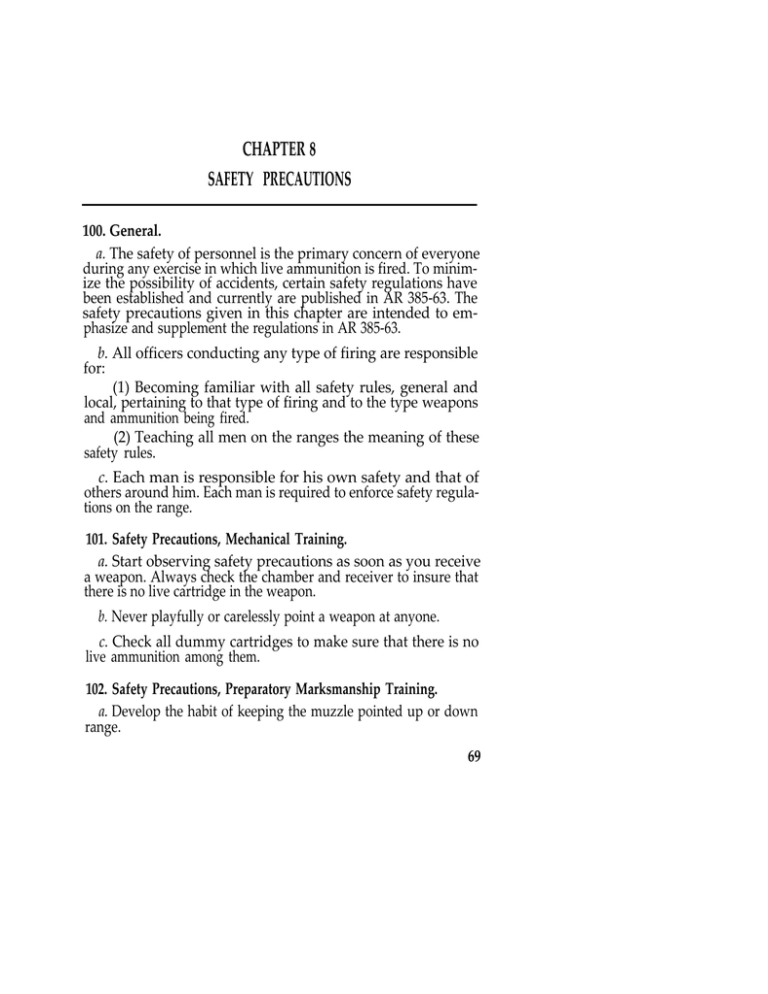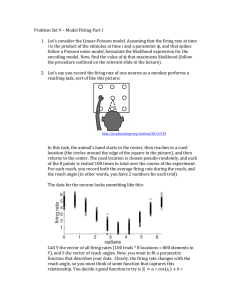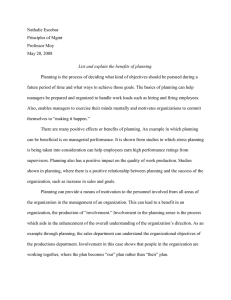chapter 8 safety precautions
advertisement

CHAPTER 8 SAFETY PRECAUTIONS 100. General. a. The safety of personnel is the primary concern of everyone during any exercise in which live ammunition is fired. To minimize the possibility of accidents, certain safety regulations have been established and currently are published in AR 385-63. The safety precautions given in this chapter are intended to emphasize and supplement the regulations in AR 385-63. b. All officers conducting any type of firing are responsible for: (1) Becoming familiar with all safety rules, general and local, pertaining to that type of firing and to the type weapons and ammunition being fired. (2) Teaching all men on the ranges the meaning of these safety rules. c. Each man is responsible for his own safety and that of others around him. Each man is required to enforce safety regulations on the range. 101. Safety Precautions, Mechanical Training. a. Start observing safety precautions as soon as you receive a weapon. Always check the chamber and receiver to insure that there is no live cartridge in the weapon. b. Never playfully or carelessly point a weapon at anyone. c. Check all dummy cartridges to make sure that there is no live ammunition among them. 102. Safety Precautions, Preparatory Marksmanship Training. a. Develop the habit of keeping the muzzle pointed up or down range. 69 b. Carry the weapon with the magazine removed, chamber empty, bolt forward, and cover closed. c. Comply with all commands of the officer in charge and the coach. 103. Safety Precautions, Range Firing. a. Safety precautions must be observed on the range, A safety officer/NCO should be designated with the specific duty of insuring that all safety precautions are being observed. Each coach will require his firer to observe safety precautions. b. Safety precautions listed above for mechanical training and preparatory marksmanship training also apply during range practice. c. Precautions to be observed prior to firing include: (1) Do not draw or issue ammunition until the officer in charge of firing gives the command. (2) Do not start firing until: (a) All personnel are oriented regarding safety regulations and other pertinent information. (b) Roadblocks are established and road guards are posted. (c) A red streamer is displayed from a prominent place on the range. (d) All weapons are checked by an officer to insure that none contain live ammunition. The bores of weapons to be fired must be checked to insure that they contain no obstructions such as rust-preventive compound, cleaning patches, mud, or snow. (e) Markers are placed at the right and left safety limits, and personnel are warned not to fire outside of the markers. d. Precautions to be observed during firing include: (1) Weapons will be loaded and unloaded on the firing line, on command of the officer in charge. (2) The commands COMMENCE FIRING and CEASE FIRING are given loud and clear (whistle signals may be used when necessary). Anyone who considers it necessary to insure safety may give the command CEASE FIRING. When a firer hears the command CEASE FIRING, he will take his finger off the trigger, close the cover, and wait for further instructions. (3) As soon as the firing exercise is completed, or on command, the firer will clear his weapon. 70 (4) No one will move in front of the firing line unless directed to do so by the officer in charge, who, before giving the command, will have all weapons cleared, checked by the safety officer/NCO or coach, and grounded. (5) No weapon is moved in front of the firing line. (6) No weapon will be removed from the firing line until it has been checked, by the safety officer/NCO or one of his representatives, to see that it is clear. (7) Proper care will be given ammunition (para 52). (8) All accidents will be immediately reported to the officer in charge. AR 385–63 prescribes the report that will be made for accidents involving faulty weapons or ammunition. AR 38540 prescribes the report that will be made for accidents that are not the result of faulty weapons or ammunition. (9) When guns are being fired from vehicles, a red flag will be displayed on each vehicle while the gun in that vehicle is loaded. e. Precautions to be observed after firing include: (1) All brass and live cartridges will be kept separate. Brass will be inspected to insure that there are no empty cartridge cases with unexploded primers. (2) All cardboard ammunition cartons will be inspected to insure that they contain no live cartridges or brass. (3) Before any weapon is removed from the firing line or from the range, it will be checked to insure that it contains no live ammunition. (4) All personnel are inspected to insure that no unauthorized person is carrying live ammunition or brass from the range. (5) All range flags are taken down, and the road guards are withdrawn from their posts. 71




